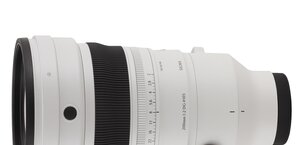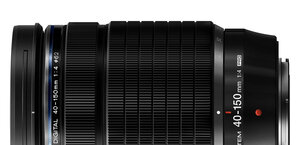Canon EF-S 18-55 mm f/3.5-5.6 IS II
3. Build quality and image stabilization
In The photo below you can see the new kit lens’s dimensions compared to those of its 18-135 mm and 18-200 mm equivalents.
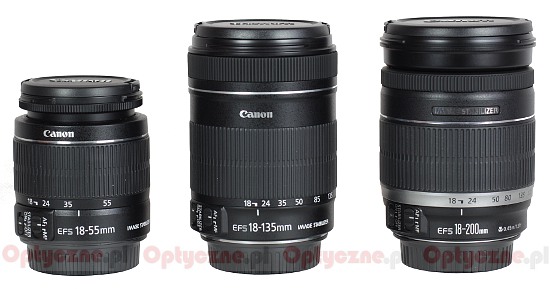 |
Please Support UsIf you enjoy our reviews and articles, and you want us to continue our work please, support our website by donating through PayPal. The funds are going to be used for paying our editorial team, renting servers, and equipping our testing studio; only that way we will be able to continue providing you interesting content for free. |
- - - - - - - - - - - - - - - - - - - - - - - - - - - - - - - - - - - - - - - - - - - - - - - -
The lens starts with a plastic mount, featuring a protuberance so characteristic for EF-S devices which makes it impossible to attach them to any full frame reflex cameras. The idea behind such a mount is not very clear to me, especially nowadays. I really don’t understand why Canon hasn’t got rid of this inconvenience yet, allowing to attach lenses designed for smaller sensors to full frame cameras, like in the case, for example, of Nikon reflex cameras.
On the mount you can find some contacts and an inscription informing us that the lens was produced in Taiwan. Inside the mount there is a mobile rear element with less than 17 mm in diameter. It is positioned almost on the same level as the mount at 18 mm and it is hidden the deepest inside the casing at 55 mm.
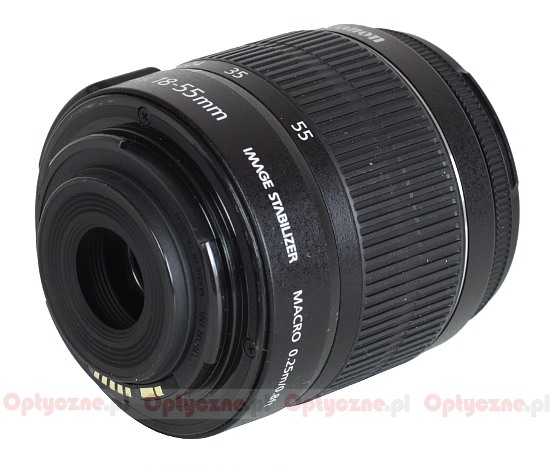 |
Already on the lens we can find another inscription: “EFS 18–55mm IMAGE STABILIZER MACRO 0.25m/0.8ft” and, on the left, focus mechanism mode switches (AF/MF) and a stabilization switch (STABILIZER ON/OFF). Contrary to its predecessor, the mark indicating the right fixing position is not any longer a separate piece of plastic, glued inside the casing, but a white, painted square . The example of cost-cutting exercise. Save every penny…
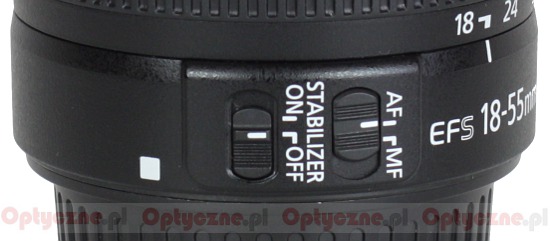 |
The next change, compared to the previous model, is the lack of a silver ring with focal lengths’ markings. Now they are situated immediately on the barrel right below the zoom ring which is made of ribbed rubber and 27 mm wide. The ring is well-damped and works smoothly. The ribbing ends with a silver stripe with the Canon company logo – it is another change because the predecessor had an inscription “IMAGE STABILIZER” there.
The manual focus ring remained a narrow, hardly comfortable dummy, unfit for any precise work. Running through the distance scale takes a 70-degree turn so we can’t speak about great precision of settings.
The front element system, surrounded by that ring and a rotating filter thread, 58 mm in diameter; it extends with the change of focal length. The lens is the smallest at 26-28 mm and it becomes longer both during shortening and lengthening the focal lengths.
Inside the Canon EF-S 18-55 mm IS II you can find 11 elements positioned in 9 groups. One of them (the penultimate) is aspherical. A single mobile lens no. 5 is responsible for the image stabilization system. Between elements no. 7 and no. 8 you can also find an aperture with six diaphragm blades which, depending on the focal length, can be closed down to f/22-36.
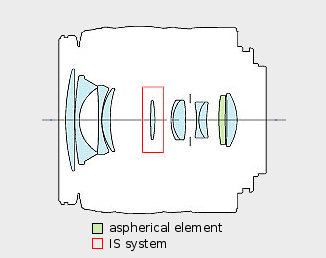
Only caps can be found in the standard accessory kit. Either a hood (EW-60C) or a case (LP814) are optional. In this category the Canon lags behind e.g. the Pentax with which we get a hood included in box.
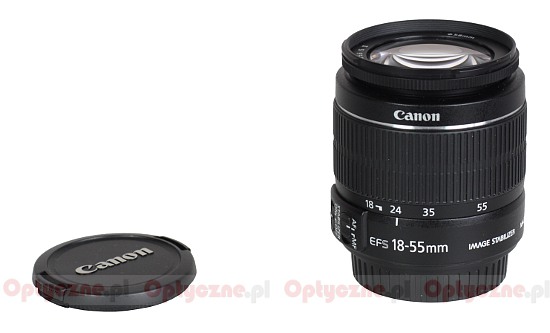 |
Stabilization
It is difficult to say what stabilization efficiency is assumed by the Canon company for their equipment. In one place they say something about four stops which might indicate an efficiency on the level of 4 EV. In other place they announce the possibility of lengthening the time of exposure by four which might suggest the stabilization on the level of 2EV. In order to get a reference point it’s worth reminding here that the stabilization of the tested lens’s predecessor could be as efficient as 2.0-2.5 EV which was a decent result.
In the case of the EF-S 18-55 mm f/3.5–5.6 IS II we also conducted a stabilization test, according to our standard procedures. We set the focal length at 55 mm and we took two series of photos (with the stabilization switched on and off) for exposure times ranging from 1/100 to 1/5 of a second. Then we assessed the percentage of blurred photos for every exposure and the results are presented on the graph below.
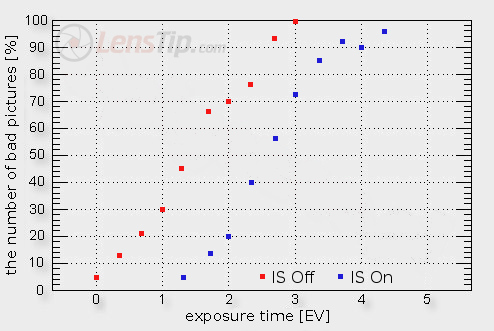
As you can notice the result is quite surprising. The stabilization is not at all better than in the case of its predecessor. We didn’t count on it at all by the way because if it were better, it would rival some L-class lenses and Canon wouldn’t want to tolerate such a rivalry. We expected a result at the level of 2 EV - typical for this category of lenses. The actual result of the Canon 18-55 mm IS II proved to be lower as the stabilization efficiency of this lens we asses as 1.3 EV.




